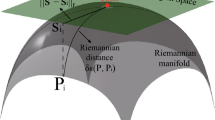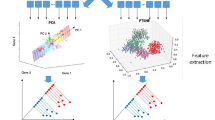Abstract
Brain computer interface (BCI) based on motor imagery (MI) provides a communication channel between the brain and a computer or other communication devices. In BCI system, electroencephalogram (EEG) is the most widely used brain signals, which has the function of responding to the physiological and emotional information of the brain. The recognition of MI EEG signals is the core technology of MI-BCI system. In this study, semi-supervised learning strategy is adopted in model training, and semi-supervised classifier with projection graph embedding (SCPGE) is proposed for MI EEG recognition. SCPGE combines graph embedding projection and sparse constraint into semi-supervised least squares model to learn the discriminative structure of EEG data in projection space, and adaptively learns the similarity matrix and pseudo-label matrix based on manifold learning. Unlike the “two-step” strategy of constructing graph embedding and classifier, these two factors, together with subspace projection and pseudo-label estimation, are simultaneously considered in the objection function and optimized in the iteration process. In addition, SCPGE uses the class by class based ℓ2, 1-norm inter class sparsity constraint to exploit the correlation between samples, so as to obtain the discriminative projection matrix and classifier. Experiments on the publicly available MI EEG datasets show that SCPGE classifier can significantly improve the recognition accuracy.









Similar content being viewed by others
Data availability
The datasets presented in this study can be found in online repositories
BCI Competition III, IVa can be found below: https://www.bbci.de/competition/iii/
BCI Competition IV, IIa can be found below: https://www.bbci.de/competition/iv/
References
Belkin M, Niyogi P, Sindhwani V (2006) Manifold regularization: a geometric framework for learning from labeled and unlabeled examples. J Mach Learn Res 7(85):2399–2434
Blankertz B, Muller KR, Krusienski DJ, Schalk G, Wolpaw JR, Schlogl A, Pfurtscheller G, Millan JR, Birbaumer N (2006) The BCI competition III: Validating alternative approaches to actual BCI problems. IEEE Trans. Neural Systems and Rehabilitation. Engineering 14(2):153–159
Brunner C, Naeem M, Leeb R, Graimann B, Pfurtscheller G (2007) Spatial filtering and selection of optimized components in four class motor imagery EEG data using independent components analysis. Pattern Recogn Lett 28(8):957–964
Chen X, Yuan G, Nie F, Ming Z (2020) Semi-supervised feature selection via sparse rescaled linear square regression. IEEE Trans Knowl Data Eng 32(1):165–176
Chen C, Wang Z, Wu J, Wang X, Guo LZ, Li YF, Liu S (2021) Interactive graph construction for graph-based semi-supervised learning. IEEE Trans Visual Comput Graph 27(9):3701–3716
Dornaika F, Baradaaji A. E, Traboulsi Y (2021) Semi-supervised classification via simultaneous label and discriminant embedding estimation. Inf Sci, 546(1): 146–165
Gu X, Zhang C, Ni T (2021) A hierarchical discriminative sparse representation classifier for EEG signal detection. IEEE/ACM Trans Comput Biology Bioinform 18(5):1679–1687
Guan G, Hu Y, He Q, Leng B, Wang H, Zou H, Wu W (2013) Joint Rayleigh coefficient maximization and graph based semi-supervised for the classification of motor imagery EEG. Proceedings of 2013 IEEE International Conference on Information and Automation (ICIA), Yinchuan, China: 379–383.
Hang W, Li Z, Yin M, Liang S, Shen H, Wang Q, Qin J, Choi K (2023) Deep stacked least square support matrix machine with adaptive multi-layer transfer for EEG classification. Biomed Signal Proc Contr 82(4):104579
Higashi H, Tanaka T (2013) Simultaneous design of FIR filter banks and spatial patterns for EEG signal classification. IEEE Trans Biomedical Engineering 60(4):1100–1110
Lei Y, Cen L, Chen X, Xie Y (2019) A hybrid regularization semi-supervised extreme learning machine method and its application. IEEE Access 7:30102–30111
Liu G, Tian L, Zhou W (2022) Multiscale time-frequency method for multiclass Motor Imagery Brain Computer Interface. Comput Biol Med 143(4):105299
Liu Z, Wang L, Xu S, Lu K (2022) A multiwavelet-based sparse time-varying autoregressive modeling for motor imagery EEG classification. Comput Biol Med 2022:106196
Lu X, Long J, Wen J, Fei L, Zhang B, Xu Y (2022) Locality preserving projection with symmetric graph embedding for unsupervised dimensionality reduction. Pattern Recogn 131(11):108844
Luo F, Zou Z, Liu J, Lin Z (2021) Dimensionality reduction and classification of hyperspectral image via multistructure unified discriminative embedding. IEEE Trans Geosci Remote Sensing 60(11):5517916
Moradi MH (2022) A novel metaheuristic optimization method for robust spatial filter designation and classification of speech imagery tasks in EEG brain-computer interface. Artific Intel-Based Brain-Comput Inter 2022:237–259
Ni T, Chung FL, Wang S (2015) Support vector machine with manifold regularization and partially labeling privacy protection. Inf Sci 294(2):390–407
Nie F, Wang X, Huang H (2014) Clustering and projected clustering with adaptive neighbors. In Proceedings of the 20th ACM SIGKDD international conference on Knowledge discovery and data mining, New York USA: 977-986.
Peng Y, Jin F, Kong W, Nie F, Lu BL, Cichocki A (2022) OGSSL: a semi-supervised classification model coupled with optimal graph learning for EEG emotion recognition. IEEE Trans. Neural Systems and Rehabilitation. Engineering 30(5):1288–1297
Sadiq MT, Yu X, Yuan Z, Fan Z, Rehman AU, Li G, Xiao G (2019) Motor imagery EEG signals classification based on mode amplitude and frequency components using empirical wavelet transform. IEEE Access 7:127678–127692
Sanodiya RK, Mishra S, Arun PV (2022) Manifold embedded joint geometrical and statistical alignment for visual domain adaptation. Knowl-Based Syst 257(9):109886
She Q, Zhou Y, Gan H, Ma Y, Luo Z (2019) Decoding EEG in motor imagery tasks with graph semi-supervised broad learning. Electronics 8(11):1273
Tangermann M, Müller KR, Aertsen A, Birbaumer N, Braun C, Brunner C, … Blankertz B (2012) Review of the BCI competition IV. Front Neurosci 6:00055
Taran S, Bajaj V (2019) Motor imagery tasks-based EEG signals classification using tunable-Q wavelet transform. Neural Comput Applic 31:6925–6932
Van EJE, Hoos HH (2020) A survey on semi-supervised learning. Mach Learn 109(2):373–440
Zhang Z, Zhao M, Chow TW (2013) Graph based constrained semi-supervised learning framework via label propagation over adaptive neighborhood. IEEE Trans. Knowl Data Eng 27(9):2362–2376
Zou Y, Zhao X, Chu Y, Xu W, Han J, Li W (2022) A supervised independent component analysis algorithm for motion imagery-based brain computer interface. Biomed Sign Proc Control 75(5):103576
Acknowledgements
This work was supported in part by the Natural Science Foundation of Jiangsu Province under Grant BK 20211333.
Author information
Authors and Affiliations
Corresponding author
Additional information
Publisher’s note
Springer Nature remains neutral with regard to jurisdictional claims in published maps and institutional affiliations.
Appendices
Appendix A
Optimization of objective Eq. (9).
As each ith element in siis independent, it can be calculated separately for each i, and Eq. (11) can be simplified as,
where the matrix D = [d1, d2, …, dn] is defined as \({d}_{ij}={d}_{ij}^x+\mu {d}_{ij}^f\).
Through the Lagrange multipliers method, the closed-form solution of sican be obtained as,
where x+ = max (x, 0)+. The elements of \({\hat{\textbf{d}}}_i\) are the same as those of di with the ascending order. m is the parameter to control the number of nearest neighbors.
According to [18], the trade-off parameter α can be represented as,
Appendix B
Optimization of objective Eq. (12).
Eq. (12) can be represented as,
The Lagrange dual method is used to solve Eq. (24). Let A = μLs, uu + λI, B = λZuTPW − μFLTLs, lu, Eq. (24) can be represented as,
where η > 0and \(\overline{\boldsymbol{\upbeta}}\ge \textbf{0}\) are Lagrangian multipliers.
Thus, Fu has the closed-form solution as,
Appendix C
Optimization of objective Eq. (16).
Similarly, we denote the diagonal matrix E ∈ Rp × p, \(\textbf{E}=\left[\begin{array}{c}\frac{1}{2{\left\Vert {p}_1\right\Vert}_2}\dots 0\\ {}\vdots \vdots \\ {}0\cdots \frac{1}{2{\left\Vert {p}_p\right\Vert}_2}\end{array}\right]\), Eq. (16) can be represented as,
Using the Lagrangian multipliers method, Eq. (27) can be represented as,
where σ is the Lagrangian multiplier.
It is difficult to obtain the closed solution of P through Eq.(28). According to the gradient descent algorithm, the solution expression of P is
The first derivative ∇P of P is,
Rights and permissions
Springer Nature or its licensor (e.g. a society or other partner) holds exclusive rights to this article under a publishing agreement with the author(s) or other rightsholder(s); author self-archiving of the accepted manuscript version of this article is solely governed by the terms of such publishing agreement and applicable law.
About this article
Cite this article
Ni, T., He, C. & Gu, X. Semi-supervised classifier with projection graph embedding for motor imagery electroencephalogram recognition. Multimed Tools Appl 83, 14189–14209 (2024). https://doi.org/10.1007/s11042-023-16010-8
Received:
Revised:
Accepted:
Published:
Issue Date:
DOI: https://doi.org/10.1007/s11042-023-16010-8




